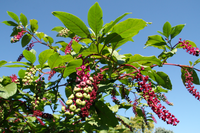
In angiosperms, a hypanthium or floral cup is a structure where basal portions of the calyx, the corolla, and the stamens form a cup-shaped tube. It is sometimes called a floral tube, a term that is also used for corolla tube and calyx tube. It often contains the nectaries of the plant. It is present in many plant families, although varies in structural dimensions and appearance. This differentiation between the hypanthium in particular species is useful for identification. Some geometric forms are obconic shapes as in toyon, whereas some are saucer-shaped as in Mitella caulescens.

An inflorescence, in a flowering plant, is a group or cluster of flowers arranged on a stem that is composed of a main branch or a system of branches. An inflorescence is categorized on the basis of the arrangement of flowers on a main axis (peduncle) and by the timing of its flowering.
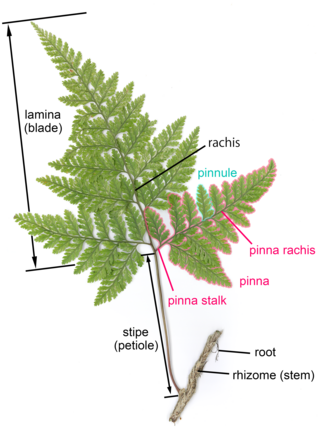
A frond is a large, divided leaf. In both common usage and botanical nomenclature, the leaves of ferns are referred to as fronds and some botanists restrict the term to this group. Other botanists allow the term frond to also apply to the large leaves of cycads, as well as palms (Arecaceae) and various other flowering plants, such as mimosa or sumac. "Frond" is commonly used to identify a large, compound leaf, but if the term is used botanically to refer to the leaves of ferns and algae it may be applied to smaller and undivided leaves.
In botany, an umbel is an inflorescence that consists of a number of short flower stalks that spread from a common point, somewhat like umbrella ribs. The word was coined in botanical usage in the 1590s, from Latin umbella "parasol, sunshade". The arrangement can vary from being flat-topped to almost spherical. Umbels can be simple or compound. The secondary umbels of compound umbels are known as umbellules or umbellets. A small umbel is called an umbellule. The arrangement of the inflorescence in umbels is referred to as umbellate, or occasionally subumbellate.

Multi-fruits, also called collective fruits, are fruiting bodies formed from a cluster of flowers, the inflorescence. Each flower in the inflorescence produces a fruit, but these mature into a single mass. After flowering, the mass is called an infructescence. Examples are the fig, pineapple, mulberry, osage-orange, and jackfruit.
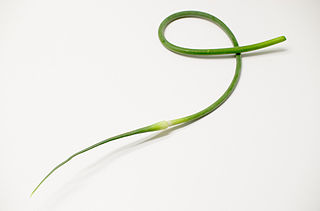
In botany, a scape is a peduncle arising from a subterranean or very compressed stem, with the lower internodes very long and hence few or no bracts except the part near the rachis or receptacle. Typically it takes the form of a long, leafless flowering stem rising directly from a bulb, rhizome, or similar subterranean or underwater structure.

A pseudanthium is an inflorescence that resembles a flower. The word is sometimes used for other structures that are neither a true flower nor a true inflorescence. Examples of pseudanthia include flower heads, composite flowers, or capitula, which are special types of inflorescences in which anything from a small cluster to hundreds or sometimes thousands of flowers are grouped together to form a single flower-like structure. Pseudanthia take various forms. The real flowers are generally small and often greatly reduced, but the pseudanthium itself can sometimes be quite large.

In botany, a pedicel is a stem that attaches a single flower to the inflorescence. Such inflorescences are described as pedicellate.
This page provides a glossary of plant morphology. Botanists and other biologists who study plant morphology use a number of different terms to classify and identify plant organs and parts that can be observed using no more than a handheld magnifying lens. This page provides help in understanding the numerous other pages describing plants by their various taxa. The accompanying page—Plant morphology—provides an overview of the science of the external form of plants. There is also an alphabetical list: Glossary of botanical terms. In contrast, this page deals with botanical terms in a systematic manner, with some illustrations, and organized by plant anatomy and function in plant physiology.
Pseuduvaria galeata is a species of plant in the family Annonaceae. It is a tree endemic to Peninsular Malaysia. James Sinclair, the Scottish botanist who first formally described the species, named it after the dome formed by inner petals shaped like a helmet.
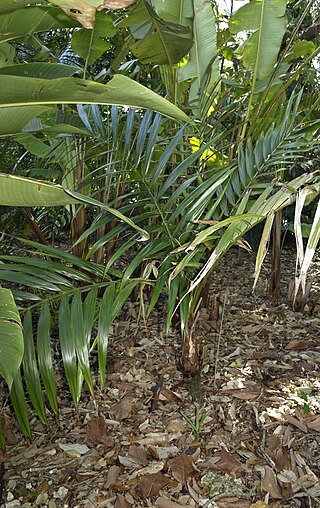
Neonicholsonia is a monotypic genus of flowering plant in the palm family native to Central America. The sole species is Neonicholsonia watsonii. The genus and species names honor George Nicholson, a former curator of the Royal Botanic Gardens, Kew and his successor William Watson.
Plectocomiopsis is a dioecious genus of flowering plant in the palm family found in Indochina, Malaysia, Borneo and Sumatra. Hapaxanthic and armed with spines, they are a climbing rattan, closely related to the Myrialepis palms. The name is Greek for "similar to Plectocomia", another close relative.

Allagoptera caudescens is a species of flowering plant in the palm family endemic to Brazil, where it is known as buri palm. The older name Polyandrococos combines the Greek words for "many" and "anther" with the name of another palm genus Cocos, and the epithet is Latin for "bearlike", referring to the hairy tomentum. It was formerly classified as Polyandrococos caudescens, the only species in the genus Polyandrococos.
This glossary of botanical terms is a list of definitions of terms and concepts relevant to botany and plants in general. Terms of plant morphology are included here as well as at the more specific Glossary of plant morphology and Glossary of leaf morphology. For other related terms, see Glossary of phytopathology, Glossary of lichen terms, and List of Latin and Greek words commonly used in systematic names.

In botany, sessility is a characteristic of plant organs such as flowers or leaves that have no stalk. Plant parts can also be described as subsessile, that is, not completely sessile.
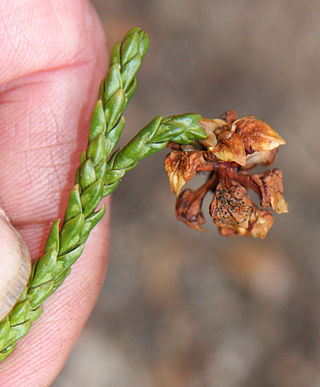
In plant morphology, a cataphyll is a reduced, small leaf. Many plants have both "true leaves" (euphylls), which perform most of the photosynthesis, and cataphylls, which are modified to perform other functions.
Pseuduvaria glossopetala is a species of plant in the family Annonaceae. It is native to the Malay Peninsula. Yvonne Chuan Fang Su and Richard M.K. Saunders, the botanists who first formally described the species, named it after the tongue shaped gland on their inner petals.
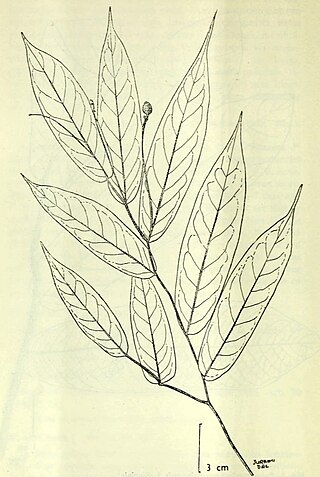
Pseuduvaria sessilifolia is a species of plant in the family Annonaceae. It is native to New Guinea. James Sinclair, the botanist who first formally described the species, named it after its stalkless leaves which lack petioles.

Pseuduvaria unguiculata is a species of plant in the family Annonaceae. It is endemic to The Philippines. Adolph Daniel Edward Elmer, the American botanist who first formally described the species, named it after its clawed inner petals.

Pseuduvaria villosa is a species of plant in the family Annonaceae. It is endemic to Australia. L.W. Jessup, the botanist who first formally described the species, named it after its leaves and branchlets which are shaggy with long soft hairs.
